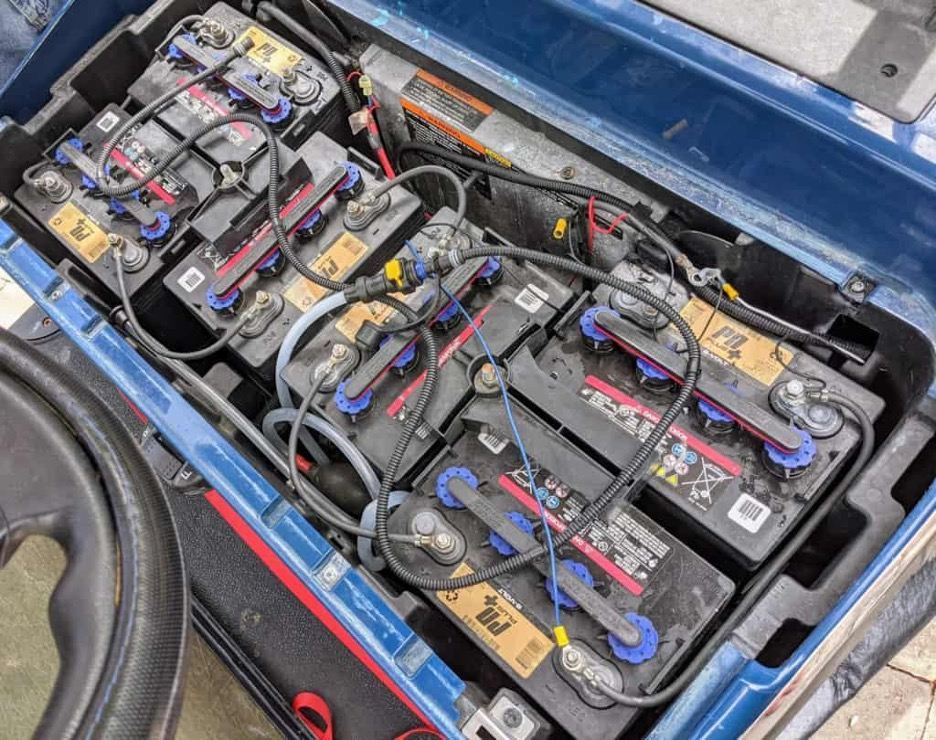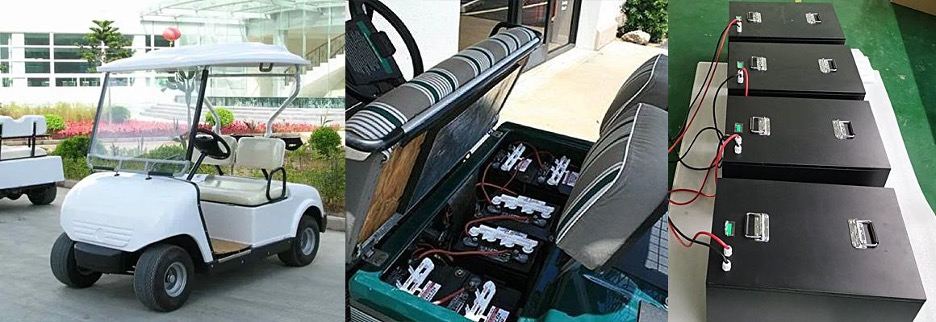
Lithium Batteries for Golf Carts: Everything you Need to Know
Golf cart batteries are the fuel that powers electric golf carts and is available in a variety of sizes and types. And golf carts aren’t just for golfers these days.
Many seaside towns and retirement communities have folks driving around in electric golf carts. They’re also frequently used as maintenance vehicles at resorts, zoos, and parks where visitors don’t want to smell the fumes or hear the loud engines of regular gasoline-powered vehicles.
You probably think little about the batteries in your golf cart, but understanding how they function and maintaining them is crucial to your golf cart’s performance. The battery system configuration determines the speed, acceleration, and runtime of electric golf carts.
Buying lithium golf cart batteries by Eco Tree Lithium will allow you to get the most out of your electric golf cart. Let’s get started!
What Exactly Are Golf Cart Batteries?
Electric golf motors typically operate at 36 or 48 volts and take 50-70 amps of electricity when cruising at about 15 miles per hour. Keep in mind that the current draw is substantially higher during acceleration or while climbing a slope. Golf cart batteries must provide a constant flow of high current for extended periods to keep you from becoming stuck.
Golf cart batteries typically go through full charge and discharge cycles every day. Draining batteries below 50% is difficult on them and frequently results in a shortened lifespan and decreased performance.
Golf cart batteries are deep-cycle batteries that are developed and engineered to withstand lengthy current demand and frequent deep discharge. They are typically available in 6, 8, and 12-volt forms and can be wired in series to generate the voltage. Six 6-volt batteries connected in series, for example, would generate 36 volts, whereas four 12-volt batteries would provide 48 volts.
Lower voltage batteries have greater amp-hour capacity. For example, if you needed 48 volts for your golf cart motor, eight 6-volt batteries would have more capacity and would last longer than six 8-volt batteries. This occurs since you are using more batteries overall.

Is it Possible to Use Regular Car Batteries in a Golf Cart?
The quick answer is yes. Standard car batteries are 12 volts, and you could connect three or four of them in series to supply the 36 or 48 volts required by your golf cart motor.
However, the architecture of automotive batteries allows for a large surge of current for short periods. The purpose of the battery in your car is to give electricity while starting the engine. The alternator then takes over to power all of your vehicle’s electronics. Continually depleting a normal automobile battery below 50% would quickly damage it.
So, while ordinary automobile batteries can be used in a golf cart, they are unlikely to last long.
Deep-cycle batteries are intentionally designed to deliver constant current production over long periods and to be repeatedly thoroughly depleted. As a result, they are a far better solution for golf cart applications.
Lithium vs. Lead-Acid Golf Cart Batteries
Deep-cycle golf cart batteries are classified into three types: lithium-ion, lead-acid and absorbed glass mats (AGM). Each has advantages and disadvantages.
Lead-Acid
Lead-acid batteries are the most popular and least expensive deep-cycle golf cart batteries. They comprise lead plates suspended in a sulfuric acid solution that causes a chemical reaction that allows energy to be stored.
The primary advantage of lead-acid batteries is that they have the lowest initial cost. They do, however, have the shortest lifespan of any golf cart battery type, require the most maintenance, and are the heaviest.
AGM
Absorbed Glass Mat (AGM) batteries are a type of sealed lead-acid battery. The lead plates in an AGM battery are sandwiched between electrolyte-saturated fibreglass mats. AGM construction eliminates the need to refill the battery fluid and allows them to be sealed, resulting in leak-free batteries.
AGM batteries require less maintenance than traditional lead-acid batteries. Unfortunately, AGM batteries can be much more expensive without providing significantly more capacity.
Lithium-Ion
Deep-cycle lithium iron phosphate (LiFeO4) batteries are used in golf carts. These are not to be confused with the lithium batteries seen in small electronics. LiFeO4 batteries are one of the safest and most stable types of Li-ion batteries. They provide a constant current output.

Best Golf Cart Batteries: Lithium-Ion
Lithium batteries have several advantages over lead-acid and AGM batteries, including a longer lifespan, significant weight reduction, increased efficiency, and a lower overall cost.
Because of these benefits, lithium batteries are the best choice for golf cart batteries.
To get the best performance, converting your golf cart to run on lithium batteries may cause some further adjustments. Lithium batteries charge much faster than lead-acid batteries when used with the right charger. Depending on the charger in your golf cart, you may need to replace it with one that is designed specifically for lithium batteries.
When lithium batteries are depleted, their voltage does not decrease. This is a significant advantage, as we will see shortly. The only disadvantage is that because the voltage does not diminish, there is no signal that your battery is failing until it is completely dead.
With this in mind, we recommend adding a battery monitor, such as the Victron BMV-700. The battery meter shows you how much charge you have left and keeps you from becoming stranded.
Is it okay to use Battle Born batteries in my golf cart?
Yes, Battle Born Batteries may be used in your golf cart! They require a golf cart equipped with a governor. Governors restrict the pace of the golf cart, which limits the current draw. Battle Born Batteries may discharge at up to 200 amps for 30 seconds and have a continuous discharge current limit of 100 amps. If these limits are exceeded, the battery will be turned off.
All Battle Born Batteries are 12 volts. For a 36-volt system, connect three of them in series, or four in series for a 48-volt system. Connecting extra batteries in parallel will provide more run time capacity.

Benefits of Lithium Batteries over Lead-Acid
Lithium batteries offer significant advantages over lead acid for golf cart applications. Let’s inspect each of them.
Longer Lifespan and Warranty
Because lead-acid batteries go through charge and discharge cycles, they can never be fully charged to their initial capacity. They gradually wear out until the voltage drop mentioned above becomes too great. When this happens, even with a full charge, the battery can no longer power your golf cart. Lithium batteries are not like this.
Lithium batteries typically have a lifespan of five to ten times that of lead-acid batteries. Lithium batteries are real deep-cycle batteries, with repeated charge and discharge cycles having little effect on their longevity.
Battle Born lithium batteries are typically covered by a 10-year warranty. In comparison, lead-acid batteries often carry a 1-2 year limited guarantee.
More Energy-Effective
The voltage curve of lithium batteries is flatter than that of lead-acid batteries. Lead-acid batteries are normally only capable of being depleted to roughly half of their capacity before the voltage drop becomes too significant and your golf cart dies.
Lithium batteries can discharge virtually completely with little voltage reduction. This means that each time you charge a lithium battery, you can use nearly its entire capacity.
Lithium golf cart batteries can be fully charged in roughly two hours with the correct charger, which is substantially faster than their lead-acid equivalents.

Lighter
Lithium batteries weigh around half as much as lead-acid deep-cycle batteries. Reduced golf cart weight increases runtime, allowing you to spend more time driving and less time charging.
Lower Total Cost
Because lithium golf cart batteries last 5-10 times longer than lead-acid batteries, they have a higher initial cost but often provide overall cost savings.
Safer
Thermal runaway is a significant problem in all forms of batteries. Thermal runaway damages the battery and can start a fire if not stopped soon.
Lead-acid batteries do not protect against thermal runaways. Lithium batteries have an integrated battery management system (BMS) that aids in temperature regulation, monitors for internal shorts, and shuts down the battery if thermal runaway is detected.
Lithium battery technology advancements have made them far safer than their lead-acid rivals.

Upgrade to Lithium-Ion Batteries for Your Golf Cart
Having a dependable golf cart battery is essential whether you’re going for a game of golf or cruising around the beach. Nobody enjoys being stranded!
Lithium batteries are a terrific way to keep your cart running longer while also reducing maintenance requirements and saving you money in the long run.
Final Words
Lead-based golf cart batteries require care. They will transport you over golf courses repeatedly, but you must take care of them to get the most out of them. Few things beat climbing onto a fast golf cart on a hot day and getting that cool air between your shots to keep you from overheating.
Your golf cart is your chariot to ride into the golf course’s battleground. You’d best look after it. The tips, methods and facts about battery maintenance, above, can help you achieve this and help you get the best and longest life out of your batteries. Maintaining your batteries properly will save you money in the long term.











